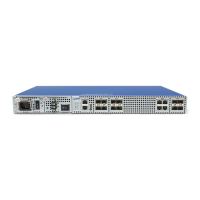UMN:CLI User Manual
V5808
672
12.2.22 CFM OAM for ONU Management
CFM OAM is now standardized as IEEE 802.1ag. CFM contains the concepts of
maintenance domains and supports autonomy for customers, providers, operators, etc. It
enables end-to-end management of connectivity and services, each domain can run its
own OAM. By CFM OAM feature, the service providers who own the network end-to-end
may be able to guarantee services over networks they own.
CFM OAM Elements
You need to know conceptual information of CFM OAM. CFM OAM consists of the
following management elements.
• Maintenance Entity (ME)
An OAM entity that requires management. An MD is owned by a ME. It is a relation-
ship between two Maintenance association end points (MEPs) within a single MA.
• Maintenance Domain (MD)
In Ethernet CFM, an MD is a management space for monitoring and administering of
a network. A network controlled by an operator that supports connectivity between
MEPs.
• Maintenance Association (MA)
A set of MEPs that belong to the same MA identifier and MD level within one service
instance to verify the integrity of the service.
• Maintenance Association End Point (MEP)
A provisioned reference point that can initiate/terminate proactive OAM frames. Each
MEP has a unique MEP ID within its MA.
• Maintenance Association Intermediate Point (MIP)
A provisioned reference point that can respond to diagnostic OAM frames initiated by
a MEP.
• Service Instance
CFM OAM defines that a service instance is one entity within MD.
CFM Messages
There are different types of CFM messages:
• Continuity Check Message (CCM)
Each MEP sends periodic CCMs to other MEPs with a multicast destination address.
The loss of CCMs that ride along the data path would indicate a connectivity failure.
• Loopback Message/Response (LBM/LBR)
A LBM is sent to a unicast destination MAC address. MEP at the destination MAC
address responds to the LBM with an LBR. These messages are useful for verifying
connectivity with a specific L2 destination.
• LinkTrace Message/Response (LTM/LTR)
A LTM is sent to a multicast MAC address. Each MIP at the same MD level responds
with a LTR. LTM is then forwarded to the next hop until it reaches the destination
MAC address. These messages are used for tracing the L2 path to a specific L2
destination.

